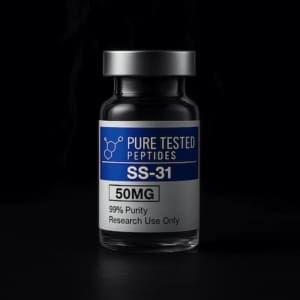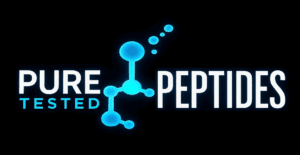SS-31 Research Overview & Where to Buy Peptides Online (Research-Only)
This page breaks down the “why” behind SS-31 (often referenced as elamipretide): what it targets inside mitochondria, the big takeaways from preclinical data, and how teams usually design experiments around it.
Everything here is strictly for laboratory research—not medical use or advice.
Quick refresher: what SS-31 is trying to doIn plain English: SS-31 is a small, mitochondria-targeting tetrapeptide designed to hang out at the inner mitochondrial membrane and interact with cardiolipin—that special phospholipid that helps organize respiratory chain supercomplexes. By stabilizing cardiolipin–protein interactions and taming excessive lipid peroxidation, SS-31 is studied for its ability to:
|
 |
Mechanism, a little deeper (but still friendly)
Think of cardiolipin as the ETC’s scaffolding glue. Under oxidative pressure it can get peroxidized, which bends membranes, loosens protein contacts, and nudges cytochrome c into peroxidase mode—none of which is great for steady ATP production. SS-31 carries a delocalized positive charge and aromaticity that help it accumulate near negatively charged cardiolipin and insert along the membrane surface. In a bunch of cell and animal models, that’s been tied to:
- Improved coupling efficiency (more ATP per oxygen) when mitochondria are stressed.
- Lower ROS signatures and less cardiolipin peroxidation, measured by lipidomics or redox dyes.
- Stabilized supercomplexes (I–III–IV), making electron transfer less leaky and more directional.
None of this guarantees a result in your system—membranes, cardiolipin content, and damage context vary by cell type and prep. But this is the working model most groups use to set up hypotheses and readouts.
What the data generally show across models
Pulling themes from preclinical literature and lab reports: SS-31 tends to look best when mitochondria are under stress (chemical, hypoxic, or age-associated). You’ll often see investigators run paired mitochondria assays—basal and stressed—so they can quantify improvements in oxygen consumption rate (OCR), coupling control, and ROS. It’s common to observe:
- Higher state 3 respiration or improved ADP/O ratios when substrates push ETC flux.
- Reduced H2O2 emission during leak conditions.
- Less cardiolipin oxidation by mass spec or targeted lipid staining techniques.
- Stabilized Δψm under stress, consistent with better inner-membrane integrity.
Some groups go beyond bioenergetics and track downstream cell behavior—calcium handling, apoptotic priming, or contractile metrics in excitable tissues. Those results are model-dependent, but the mechanistic throughline is membrane stabilization and cleaner electron flow.
 |
SS-31 10 mg
|
How labs usually build the readout panel
No single assay tells the whole story, so most teams run a “triangle” of endpoints:
- Bioenergetics: OCR/ECAR, respiratory control ratio, ADP/O, ATP:ADP.
- Redox + lipid integrity: ROS emission (Amplex, mito-targeted probes), cardiolipin oxidation, lipidomics.
- Structure & protein state: supercomplex BN-PAGE profiles, cristae ultrastructure (EM), cytochrome c localization.
Sprinkle in stress tests (FCCP titrations, antimycin/rotenone, hypoxia/reoxygenation) and you’ll quickly see if SS-31 shifts your system toward tighter coupling and lower oxidative “leak.”
Popular companions in the same research theme
 |
Ipamorelin 10 mgSlug validated: GH-axis tool to probe endocrine signals versus strictly mitochondrial effects. Using SS-31 and Ipamorelin in separate arms helps tease apart “top-down” hormonal inputs from inner-membrane stabilization effects. |
MOTS-c 10 mgSlug validated: A mitochondrial-derived peptide tied to AMPK activation and stress-responsive reprogramming. Pairing SS-31 with MOTS-c (again, separate arms) lets you compare membrane-centric improvements with signaling-centric metabolic effects. |
 |
 |
Epithalon 10 mgSlug validated: Often filed under longevity-adjacent research, Epithalon gives a contrast case for labs exploring mitochondrial function versus peptide signaling on genomic maintenance pathways. If your SS-31 experiments change respiration but not chromatin marks, that’s a nice clean separation. |
Popular product highlight: GLP3 online
GLP3-R 20 mg — buy glp3 online
Slug validated: /product/glp3-r-20mg/
Triple-agonist incretin research has become a go-to comparator in metabolic studies. If SS-31 improves mitochondrial coupling, GLP3-style constructs help you ask: how much of my readout is endocrine-driven fuel partitioning vs. genuinely better ETC performance? Run both arms, harmonize feeding state/timing, and you’ll learn fast.
Design tips (so your data pop)
|
 |
Find what you need, fast
Browse the full catalog at Pure Tested Peptides or jump to the hub:
All Peptides for Sale.
The product pages above include lot-level testing, storage notes, and key specifications for lab planning.
All compounds referenced here—including SS-31, Ipamorelin, MOTS-c, Epithalon, and GLP3—are for laboratory research and analytical purposes only. They are not for human consumption, medical, or veterinary use. No statement here is a claim of therapeutic effect.
